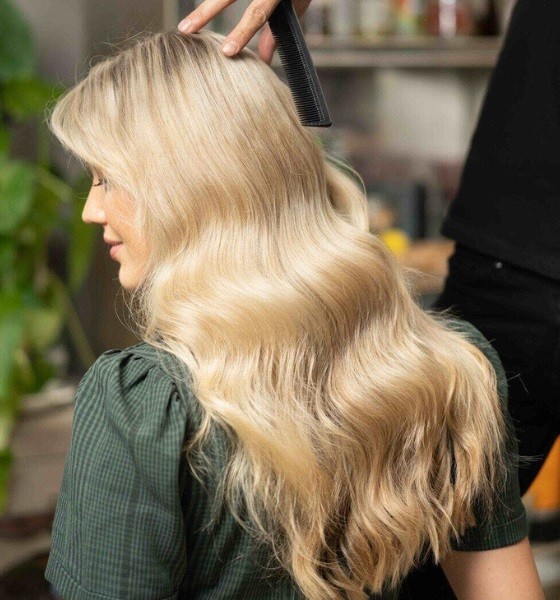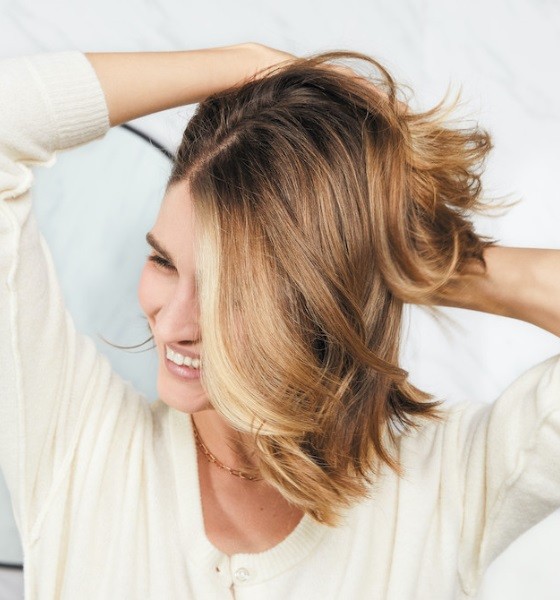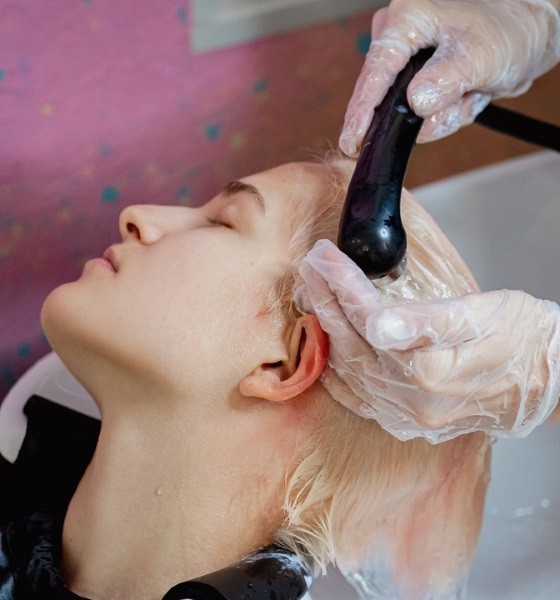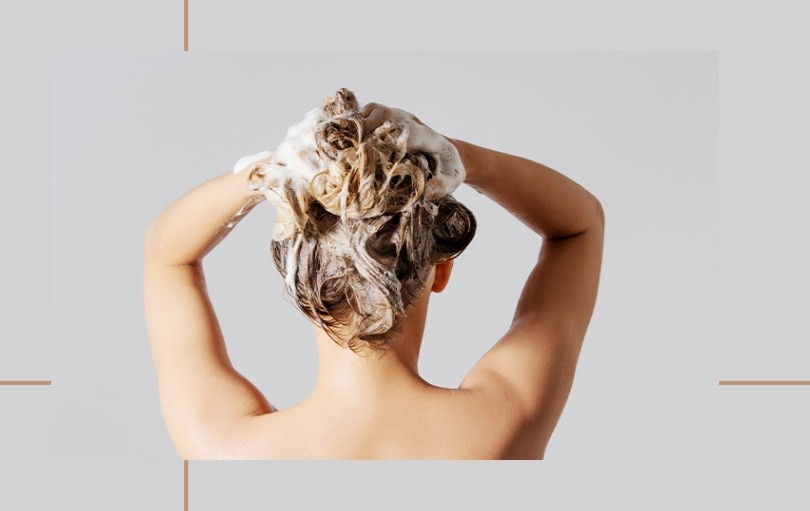Last Updated on March 28, 2025
To wash bleach out of hair, mix equal parts of water and white vinegar, apply the solution to the hair, let it sit for 10 minutes, then rinse thoroughly. Bleach can be harsh on the hair, but this method will help remove the bleach and restore its natural color and shine.
It is important to remember to always be gentle when washing hair, especially after using bleach, to minimize damage. In addition to using the vinegar solution, using a hydrating and nourishing hair mask afterward can also help to replenish moisture and promote hair health.
Ultimately, taking proper care of bleached hair is key to keeping it looking and feeling its best.
Know The Bleaching Process
Hair bleaching has become a popular trend for those who want to rock lighter locks. Before diving into the process of washing bleach out of hair, it’s crucial to understand how bleaching works and the chemical composition of bleach.
Here, we will explore what hair bleaching is, the chemical composition of bleach, and how bleach lightens hair.
What Is Hair Bleaching?

Hair bleaching is a process that involves using bleach to remove the natural color from your hair strands. It is commonly used to achieve lighter hair shades or to prepare the hair for vibrant dye colors. Hair bleach contains strong chemicals that react with melanin, which is responsible for the color of our hair, resulting in color lightening or complete removal.
The process of hair bleaching:
- Bleaching is usually performed using a powder bleach or a bleach cream, mixed with a developer.
- The mixture is applied to the hair and left for a specific amount of time, depending on the desired lighting level.
- The bleach lifts the melanin from the hair shaft, causing the hair to become lighter.
- After the desired lightness is achieved, the bleach is washed out thoroughly.
The Chemical Composition Of Bleach
Hair bleach contains key chemicals that make the lightening process possible. These chemicals work together to break down the melanin pigment in the hair strands, leading to the lightening effect.
Key components of hair bleach:
- Hydrogen peroxide: This is the main component of bleach. It acts as an oxidizing agent, breaking down the melanin pigments in the hair strands.
- Ammonia: Often found in powdered bleach, ammonia helps to open up the hair cuticles, allowing the bleach to penetrate deeper into the hair shaft.
- Persulfates or persulfate salts: These chemicals help to provide an additional boost in the lightening process by further breaking down melanin molecules.
How Does Bleach Lighten Hair?
How bleach lightens hair is crucial to properly wash it out. The process relies on the chemical reactions that occur when bleach is applied to the hair strands.
The bleaching process is explained:
- Bleach works by oxidizing the melanin pigment in the hair.
- It breaks down the melanin molecules, which are responsible for the hair’s natural color.
- The bleaching agents penetrate the hair shaft, lifting and lightening the color.
- As the melanin is gradually broken down, the hair becomes lighter in shade.
By grasping the basics of the bleaching process and the chemical composition of bleach, you are better prepared to safely wash the bleach out of your hair later on. Stay tuned for the upcoming sections, where we will explore effective methods to remove bleach from your hair and restore its natural health and shine.
Assessing The Damage
Signs Of Hair Damage From Bleach

- Dry and brittle hair: Bleaching can strip away the natural oils from your hair, leaving it dry and prone to breakage.
- Split ends: The harsh chemicals in bleach can cause the ends of your hair to split, giving it a frayed appearance.
- Hair breakage: If you notice that your hair is breaking off easily, it could be a sign of damage from bleach.
- Lack of elasticity: Bleach can decrease the elasticity of your hair, causing it to become stiff and less flexible.
- Changes in hair texture: Bleached hair may feel rough or coarse, and it may also lose its natural shine and smoothness.
Determining The Extent Of Damage
To properly address the damage caused by bleach and determine the appropriate course of action, it’s important to assess the extent of the damage. Here are some factors to consider:
- Visual inspection: Take a close look at your hair to identify any visible signs of damage, such as split ends, breakage, or changes in texture.
- Hair porosity test: Perform a simple porosity test by placing a strand of hair in a bowl of water. If it floats, your hair may have high porosity, indicating significant damage.
- Hair elasticity test: Gently stretch a strand of hair and observe if it returns to its original length. If it breaks easily or doesn’t bounce back, it could be a sign of damage.
- Hair texture changes: Pay attention to how your hair feels when you touch it. If it feels rough, brittle, or straw-like, it’s likely that damage has occurred.
Assessing the damage before washing your hair is crucial because it allows you to determine the best approach for effective repair and restoration. Keep in mind that severe damage may require professional intervention, while milder damage can often be addressed through appropriate at-home treatments.
By understanding the extent of the damage, you can take the necessary steps to protect and restore your hair to its former health and vitality.
Preparing Your Hair For The Bleach Removal Process
Bleaching your hair can leave it dry, damaged, and in need of some extra care. Before you embark on the journey of removing bleach from your hair, it’s essential to prepare your locks for the process. This involves avoiding further damage and restoring moisture and nourishment to your hair.
Here’s how you can get your hair ready to bid farewell to the bleach:
Avoiding Further Damage:
- Limit heat styling: Excessive heat can worsen the condition of your hair. Avoid using flat irons, curling wands, or blow dryers whenever possible.
- Protect with sunscreen: When stepping out into the sun, your hair needs protection too. Use UV protection sprays or wear a hat to shield your hair from harmful sun rays.
- Be gentle while brushing: Use a wide-toothed comb or a brush with soft bristles to prevent hair breakage. Start detangling from the ends and work your way up to avoid unnecessary stress on your hair strands.
- Steer clear of harsh chemicals: Refrain from using hair products that contain sulfates, alcohol, or ammonia, as these can further strip your hair of moisture.
Restoring Moisture And Nourishment To Hair:
- Hydrate from within: Drinking plenty of water helps to keep your hair and scalp hydrated, promoting healthier hair growth.
- Use a gentle shampoo: Look for sulfate-free shampoos that won’t strip away the natural oils from your hair, keeping it moisturized.
- Incorporate natural oils: Apply coconut oil, argan oil, or jojoba oil to your hair as pre-shampoo treatment. These oils help to restore moisture and nourish your locks.
- Deep condition regularly: Treat your hair to a deep conditioning treatment at least once a week to replenish moisture and restore vitality.
Using Deep Conditioning Treatments:
- Apply a generous amount of deep conditioner to your damp hair, focusing on the ends.
- Comb the conditioner through your hair to ensure even distribution.
- Leave the conditioner on for the recommended time, usually 10-30 minutes, to allow it to penetrate deeply into your hair strands.
- Rinse out the conditioner thoroughly with lukewarm water, as hot water can strip away moisture.
- For extra nourishment, you can cover your hair with a shower cap and use a hairdryer on a low setting to create heat, intensifying the conditioning process.
Preparing your hair for the bleach removal process is crucial to minimize damage and achieve optimal results. These steps and giving your hair the attention it deserves, you’re on your way to healthier, more vibrant locks. Remember, a little extra care can go a long way in rejuvenating your hair after the bleach!
Natural Remedies To Wash Bleach Out Of Hair

Clarifying with apple cider vinegar:
- Apple cider vinegar is a natural ingredient that can help remove bleach from hair.
- It works by clarifying the hair, which means it removes any buildup or residue from the bleach.
- To use apple cider vinegar for removing bleach, mix equal parts of vinegar and water in a spray bottle.
- Spray the mixture onto your hair and massage it into your scalp.
- Leave it on for about 5-10 minutes, then rinse thoroughly with water.
The hydrating properties of coconut oil:
- Coconut oil is renowned for its hydrating properties, making it an excellent choice for treating hair that has been bleached.
- It helps to nourish and moisturize the hair, preventing it from becoming dry and brittle.
- To use coconut oil, warm up a small amount and apply it to your hair, focusing on the ends and damaged areas.
- Leave it on for at least 30 minutes or overnight if possible.
- Rinse it out with warm water and shampoo as usual.
Removing bleach with lemon juice:
- Lemon juice is a natural ingredient that can help lighten and remove bleach from the hair.
- It contains citric acid, which can help break down the bleach molecules.
- Squeeze fresh lemon juice into a bowl and apply it to your hair, making sure to saturate all the bleached areas.
- Leave it on for about 20-30 minutes, then rinse thoroughly.
- Follow up with a deep conditioning treatment to restore moisture to the hair.
The conditioning effects of avocado:
- Avocado is not only a nutritious food but also an excellent natural remedy for treating bleached hair.
- It contains healthy fats and vitamins that can nourish and condition the hair, making it stronger and more resilient.
- Mash a ripe avocado and apply it to your hair, focusing on the damaged areas.
- Leave it on for at least 30 minutes, then rinse well with lukewarm water.
- Shampoo and condition as usual for best results.
Using these natural remedies can help you wash the bleach out of your hair effectively while keeping it healthy and nourished. Give them a try, and you’ll be on your way to beautiful, restored hair in no time.
Professional Haircare Products For Bleach Removal
If you’re looking to wash the bleach out of your hair, using professional haircare products can help to minimize damage and restore your hair’s natural health and shine. Here are some recommended products specifically designed for bleach removal:
Hair color removers:
- Hair color removers are formulated to effectively remove permanent hair dyes, including bleach. They work by breaking down the artificial color molecules in the hair, allowing you to start fresh.
- Look for hair color removers that are gentle and safe for use on bleached hair. These products typically contain ingredients like sulfur, which help to shrink the color molecules for easier removal.
Clarifying shampoos:
- Clarifying shampoos are specially designed to remove product buildup, including traces of bleach. They are more potent than regular shampoos and help to cleanse the hair and scalp thoroughly.
- Look for clarifying shampoos that are sulfate-free and gentle on the hair, as bleached hair is already more prone to dryness and damage. These shampoos effectively remove residual bleach without further stripping the hair’s natural oils.
Deep cleansing masks:
- Deep cleansing masks are intensive treatments that deeply cleanse the hair and remove any lingering traces of bleach. These masks help to detoxify and revive damaged hair, restoring its health and vitality.
- Look for deep cleansing masks that are enriched with nourishing ingredients like keratin, argan oil, or shea butter. These ingredients help to replenish moisture and repair the hair, leaving it soft and manageable.
Color-safe conditioners:
- After washing bleach out of your hair, it’s crucial to use a color-safe conditioner to restore moisture and prevent further damage. Color-safe conditioners are specifically formulated to protect and nourish bleached hair.
- Look for conditioners that contain ingredients like hydrolyzed silk or wheat protein, as these help to strengthen and repair the hair. Additionally, conditioners with UV filters can protect your hair from further sun-induced damage.
While professional hair care products can help to remove bleach from your hair, it’s essential to follow the instructions carefully and consult a haircare professional for personalized guidance. Maintain a proper haircare routine and avoid excessive heat styling to ensure long-lasting results and healthier, rejuvenated hair.
Step-By-Step Process To Wash Bleach Out Of Hair
Bleaching your hair can give you a bold, edgy look, but there may come a time when you want to remove the bleach and revert to your natural hair color. If you’re wondering how to wash the bleach out of hair effectively, you’re in the right place.
Follow this step-by-step process to safely and successfully remove bleach from your locks.
Preparing The Necessary Tools:
Gather the following items before starting the process:
- Mild sulfate-free shampoo
- Deep conditioning treatment
- Wide-tooth comb
- Towel
- Plastic hair cap or shower cap
Rinsing The Hair Thoroughly:
- Start by thoroughly wetting your hair with lukewarm water.
- Gently massage your scalp to help remove any excess bleach.
- Rinse your hair for several minutes, ensuring that all bleach residue is washed away.
- Pat your hair dry with a towel, leaving it slightly damp.
Applying The Chosen Bleach Removal Method:
There are multiple methods you can use to remove bleach from your hair. Choose the one that suits your hair type and preference:
Vitamin C treatment:
- Crush several vitamin C tablets into a fine powder.
- Mix the powder with a small amount of shampoo to form a paste.
- Apply the paste to your hair, focusing on the areas with the most bleach.
- Leave the mixture on for about 30 minutes before rinsing it out thoroughly.
Color remover:
- Follow the instructions on the color remover packaging carefully.
- Apply the color remover to your hair, making sure to evenly distribute it.
- Leave the color remover on for the recommended time as per the instructions.
- Rinse your hair thoroughly to eliminate any residue.
Waiting For The Recommended Time:
- Once you’ve applied the chosen bleach removal method, it’s important to give it enough time to work. Follow the instructions provided with the product you’re using and wait for the recommended duration. This allows the bleach to break down and be lifted from your hair effectively.
Washing And Conditioning The Hair:
- After the recommended waiting time, rinse your hair thoroughly with lukewarm water until the water runs clear.
- Gently shampoo your hair using a mild sulfate-free shampoo to remove any remaining bleach residue.
- Apply a deep conditioning treatment to restore moisture and nourishment to your locks.
- Leave the conditioner on for the recommended time as indicated on the product packaging.
- Rinse your hair once again, ensuring that all the conditioner is washed out.
- Towel dry your hair gently and avoid using excessive heat from styling tools immediately after removing bleach to prevent further damage.
This step-by-step process, you can successfully wash the bleach out of your hair, restoring it to its natural color. Remember to be patient and treat your hair with care to minimize any potential damage. Don’t forget to nourish your hair afterward with regular deep conditioning treatments to maintain its health and vitality.
Post-Treatment Haircare Tips
Maintaining Hair Health After Bleach Removal

After removing bleach from your hair, it is crucial to take extra care to maintain its health and prevent further damage. Post-treatment haircare plays a vital role in preserving the strength and vitality of your hair. Here are some essential tips to follow:
Regular deep conditioning treatments:
- Use a deep conditioner specifically formulated for bleached hair to restore moisture and nourishment.
- Apply the conditioner generously to your hair, focusing on the ends, where damage is often more prominent.
- Leave the conditioner on for the recommended time to allow it to penetrate the hair shaft and provide deep conditioning.
- Rinse thoroughly with cool water to seal the cuticles and retain moisture.
- Repeat this deep conditioning treatment at least once a week to keep your hair hydrated and manageable.
Protecting hair from further damage:
- Limit the use of heat-styling tools such as hairdryers, straighteners, and curling irons, as they can cause additional damage to the already weakened hair.
- If using heat-styling tools, always apply a heat protectant spray or serum to create a barrier between your hair and the heat.
- Avoid excessive brushing or combing, especially when your hair is wet, as it can lead to breakage. Use a wide-toothed comb or a detangling brush to gently work through any knots or tangles.
- Minimize exposure to the sun by wearing a hat or using a UV-protective hair spray to shield your hair from harmful UV rays.
- Consider using silk or satin pillowcases, as they cause less friction than cotton pillowcases, reducing hair breakage.
- Trim your hair regularly to remove any split ends and promote healthy hair growth.
Seeking Professional Help
Having bleach in your hair can be a major concern, especially if you’ve encountered some damage or are unsure how to proceed with the recovery process. In such cases, it’s crucial to seek professional help from a hairstylist who specializes in color correction and hair treatments.
Their expertise and experience will ensure the best possible outcome for your hair. Below are some scenarios that indicate it’s time to consult a hairstylist:
- Significant bleach damage: If your hair has been severely damaged by bleach, it’s important to consult a professional hairstylist who can assess the extent of the damage and recommend suitable treatments.
- Uneven or patchy bleaching results: If your hair has turned out uneven or patchy after attempting to bleach it at home, a hairstylist can help fix and blend the color for a more natural look.
- Hair breakage or excessive dryness: Bleach can cause hair to become brittle and prone to breakage. If you notice a significant amount of breakage or excessive dryness, a hairstylist can suggest ways to restore moisture and strengthen your hair.
- Unhappy with the results: If you aren’t satisfied with the outcome of your bleaching efforts, a hairstylist can provide professional advice and alternatives to achieve the desired result.
Professional Treatments For Severe Bleach Damage
If your hair has suffered severe damage from bleach, professional treatments can help repair and restore its health. Here are some common treatments offered by hairstylists for severe bleach damage:
- Olaplex treatment: This treatment helps repair the disulfide bonds in hair that have been broken due to bleach damage. It strengthens the hair from within and improves its overall condition.
- Deep conditioning treatments: Deep conditioning treatments infuse moisture into the hair, helping to restore elasticity and reduce dryness caused by bleach. These treatments can be customized based on the level of damage and the specific needs of your hair.
- Protein treatments: Protein treatments are ideal for hair that has lost its strength and elasticity. They help rebuild the hair’s protein structure, making it more resilient and less prone to breakage.
Expert Advice On Recovering From Bleach Damage
Recovering from bleach damage requires time, patience, and proper hair care. Here is some expert advice to help you navigate the recovery process:
- Trim regularly: Regular trims will help get rid of damaged ends and promote healthier hair growth.
- Use a sulfate-free shampoo: Sulfates can strip the hair of its natural oils, further drying it out. Opt for a gentle, sulfate-free shampoo that will cleanse your hair without causing additional damage.
- Moisturize and condition: Deep conditioning treatments and leave-in conditioners are essential to replenish moisture lost during the bleaching process. Look for products that contain hydrating ingredients such as argan oil or shea butter.
- Avoid heat styling: Excessive heat styling can further weaken and damage bleached hair. Whenever possible, let your hair air dry or use heat protectant sprays before styling.
- Protect from the sun: Ultraviolet rays can be harmful to bleached hair, causing it to become brittle and fade. Protect your hair by wearing a hat or applying a leave-in conditioner with SPF when spending time outdoors.
Remember, recovering from bleach damage takes time and consistent care. Be patient, follow these expert tips, and don’t hesitate to reach out to a hairstylist for professional guidance and treatments.
Preventing Future Hair Damage
To keep your hair healthy and avoid damage after bleaching or dyeing, there are several precautions and alternatives to consider. Here are some helpful tips to protect your hair from future harm:
Alternatives To Bleach For Hair Lightening:
- Lemon juice: Apply lemon juice to your hair and expose it to sunlight for a natural lightening effect.
- Chamomile tea: Brew chamomile tea, let it cool, and rinse your hair with it for gradual lightening.
- Honey and cinnamon: Create a paste with honey and cinnamon, apply it to your hair, and leave it overnight for a lightening effect.
Tips For Safe Hair Dyeing:
- Patch test: Before dyeing your entire head, always perform a patch test to check for any allergic reactions or sensitivity.
- Choose the right product: Opt for high-quality hair dyes to minimize damage and achieve better results.
- Follow instructions: Read and follow the instructions on the product carefully to ensure safe and effective hair dyeing.
- Protect your skin: Apply petroleum jelly or a barrier cream around your hairline to prevent staining on your skin.
- Limit chemical processing: Try to avoid excessive dyeing or bleaching, as it can lead to severe damage and breakage.
Protecting Hair From Damage Before And After Dyeing:
- Deep conditioning: Prior to dyeing, regularly use deep conditioning treatments to strengthen and moisturize your hair.
- Limit heat styling: Minimize the use of heat styling tools like straighteners and curling irons that can further damage your hair.
- Trim regularly: Get regular trims to eliminate split ends and maintain healthy hair.
- Use heat protectant: When heat styling, always use a heat protectant spray to shield your hair from high temperatures.
- Avoid harsh chemicals: Choose hair care products without sulfates and parabens to minimize potential damage.
Remember, taking care of your hair is crucial in preventing future damage. By considering these alternatives, following safe dyeing practices, and implementing protective measures, you can maintain healthy and vibrant hair even after bleaching or dyeing.
Frequently Asked Questions
How To Wash Bleach Out Of Hair Without Damaging It?
To rinse bleach from your hair without causing damage, follow these steps carefully and use gentle hair care products.
Can You Remove Bleach From Hair At Home?
Yes, you can remove bleach from your hair at home by using natural remedies or purchasing specialized hair products.
What Are The Best Products To Wash Bleach Out Of Hair?
Some highly recommended products to remove bleach from hair are color-removing shampoos, moisturizing conditioners, and hair masks.
How Long Does It Take For Bleach To Wash Out Of Hair?
Bleach can take several weeks to fully fade from your hair, depending on factors such as hair type and frequency of washing.
Does Washing Hair With Vinegar Remove Bleach?
Vinegar can help remove traces of bleach from your hair, as it helps restore ph balance and seals the hair cuticle.
Conclusion
To ensure you successfully remove bleach from your hair, it is essential to follow the proper steps and take extra care. Rinse your hair thoroughly with cool water to remove any excess bleach. Then, apply a deep conditioning treatment or hair mask to restore moisture and nourish your strands.
It is crucial to avoid using any heat styling tools immediately after washing out the bleach, as your hair may be more susceptible to damage. Instead, let your hair air dry or use a cool setting on your blow dryer.
Patience is key when it comes to the bleaching process, and taking the time to properly wash out the bleach will help minimize any potential damage.

